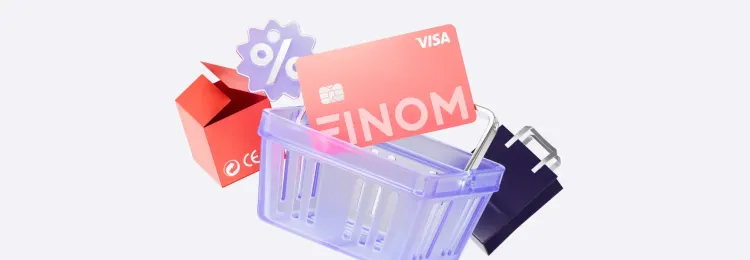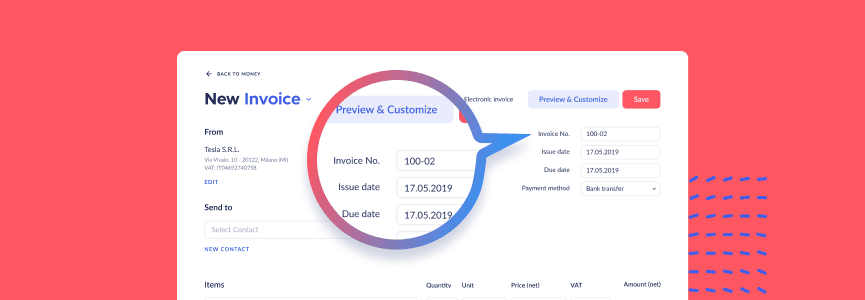An invoice number is a vital part of an invoice. The numbering helps differentiate bills correctly. Identification of sales and purchases is a crucial part of the financial system that keeps your business afloat. Assigning an invoice number to each invoice is something you must do to comply with the regulatory requirements of your country. These unique codes are usually generated via an ordered numbering system. Invoicing regulations may greatly differ depending on your place of residence. That’s why they may influence the complexity and costs of tax compliance. If your business is identified by tax authorities as non-compliant with the respective regulations, this may lead to severe risks related to tax audit or even considerable fines.
In accounting, the invoice number is a crucial element in the accounts payable and accounts receivable process, and it's used as a reference to match a payment with the correct invoice. We described how to make an invoice correctly in this article. And if you're confused about invoices and receipts, you can see their main differences here.
A well-designed system of invoice management helps you to track and review your financial activity effortlessly. You can spend hours trying to streamline it on your own or make use of Finom's top-notch invoicing service. This financial tool by Finom enables automatic invoice numbering and features an automatic reconciliation. Therefore, each payment is verified against the respective invoice without human intervention. Finom's clients don't have to think about how to generate their invoice numbers. This helps devote their time to more important business processes.
In this article, we will try to explain why invoice numbers are so important and outline the mAn intelligent person should consider making your invoice process professional
Finom tips: How to create your first invoice with Finom?
What Is an Invoice Number?
Let’s remember what purpose invoices serve. They are the bills that specify and describe services or goods a client has purchased from you; they also include the exact amount your customers have to pay.
Making your invoice process professional is something an intelligent person should consider when trying to build a business. The invoice number, also called “reference number” or “invoice ID,” is a unique number consistently assigned to each invoice. It’s a code consisting of numbers or letters (or a combination of them).
Assigning invoice numbers is not that straightforward, especially if you have many clients. There are several means of generating invoice numbers; you can choose any of the existing numbering methods that seem the most suited to your small business.
Business account with online accountingHow Many Digits Is an Invoice Number
There is no set standard for the number of digits in an invoice number. It can vary depending on the country and the specific business or organization. Some invoices may have 3 digits, while others may have 10 or more, but it should be noted that the invoice number must be unique to every invoice issued.
It is important to check the regulations or guidelines of the country where the invoice is issued for specific requirements related to invoice numbers.
Four Primary Methods for Generating an Invoice Number with Examples
There is no universal invoice numbering suitable for every vendor. That means that the final decision on which method to use is entirely up to you. Make your choice depending on what seems the most convenient and profitable method for your business. There are four standard numbering formats that are used worldwide. Let’s learn more about each of them.
Sequential Method of Invoice Numbering
A generated invoice number of this format would look like this: 001, 002, 003, etc. It’s highly recommended to use 3 or 4 digits (like in our example, it’s 001 instead of 1). This way, you will avoid future confusion as the number of your clients grows and your business continues to expand. Sequential numbering implies that with every newly issued invoice, you create a unique number for it, going up the invoice number by one. You can start the invoice number with a few zeros (the most widespread approach is to use nine zeros), followed by the actual number of the invoice.
When using invoicing software, like the service by Finom, the system will automatically assign invoice numbers to the bills with every new transaction. When you try to enter a previously recorded number, the service won’t allow you to do so.
Chronological Method of Invoice Numbering
Chronological invoice numbering is another method you can resort to. A chronological invoice number includes not only a unique number but also the date of the issuance. This method is exploited to avoid disambiguation, ensuring the invoices from the same day won’t end up with duplicate numbers. Chronological invoice numbers usually look like this: 20220928-001, 20220928-002, and so on. Therefore, you create more detailed and informative invoice numbers that have the date of the invoice issuance fixed in them.
Let’s look into the example mentioned above:
Invoice number: 20220928-001
Chronological format: YYYYMMDD-001
That means it’s the first invoice issued on September 28th, 2022. The last three digits uniquely identify the order number; the last one moves up by one with every new sale.
There are also alternative formats for chronological numbering. For example, September 28th, 2022 can also be represented as 28092022-001 (DDMMYYYY), 09282022-001 (MMDDYYYY), etc.
A chronological invoice number can be personalized even more if you add the customer’s number to it. For instance, if the customer’s number is 50 (CC), the invoice ID would look like this:
Invoice number: 20220928-50-001
Chronological format: YYYYMMDD-CC-001
Customer Invoice Numbering
As we have mentioned above, you can also assign individual customer numbers to your clients. These numbers can be added to the invoice number, thus, forming your customer invoice numbering system. Imagine you have a customer whose individual customer number is 50. In this case, a customer number-based system would have invoice numbers like these: 50-001, 50-002, and so on
Invoice numbers generated on client numbers can contain a date. In this case, the reference number starts with the client number. After, you should add the issuance date (optionally) and the sequence number at the end. Ensure your invoice number always ends with the sequence number. This simple precaution helps business owners keep track of the number of issued invoices.
That is what a sale for a customer with customer number 50 on September 28th, 2022, would look like:
Invoice number: 50-001
Invoice number with the date: 50-20220928-001
Project-Based Invoice Numbering
Another option for invoice referencing is project-based invoice numbering which has a lot in common with the client invoice numbering. In this case, business owners assign project numbers as unique numbers specifying a particular project. For instance, if a project is numbered as 183, an invoice linked to it could be 183-01, 183-02, and so on. This numbering method will be the most beneficial for small businesses that work with a wide range of different projects or offer services for companies that request the presence of project numbers on the invoices.
Discover AI AccountingFinom tips: How to personalize your invoice with Finom?
Where to Find an Invoice Number
The invoice number can typically be found on the invoice document itself, usually near the top or the header of the page. It is commonly presented as a unique identification number, often preceded by the word "Invoice," "Bill," "Purchase Order," or another similar term.
Here are the basic rules of invoice numbers that you need to be aware of:
- An invoice number should be clearly visible on each of your bills
- It is essential that the invoice number is accurate and legible on all relevant documents to ensure proper tracking and management of financial records
- Invoice numbers can be alphanumeric, which means they include both numbers and letters
- Invoice numbers typically don’t contain special symbols or characters
- An invoice number might also include a customer’s name
- An invoice number is based on the invoice number format or a numbering system that you choose
- The laws of some countries legally require including a unique invoice number on each of your invoices.
Why Are Invoice Numbers So Important for Your Business?
Assigning unique numbers to invoices is beneficial for small businesses for several reasons. They are the vital management tools that help you track multiple factors and keep your business running profitably. What’s more important, invoice numbering is often required by law. A unique number generated for each invoice allows you to:
Track Payments
When a client has problems related to an invoice issued several months ago, the bill can be easily found, provided that the vendor has a sound numbering system. Without a logical numbering system, tracking down old invoices can be really time-consuming for both the provider and purchaser. All in all, invoice numbers save vendors some headaches, serving as an excellent tool that can be supported by any accounting software and come in handy when creating a new invoice.
Without an invoice number, you will struggle to filter your invoices by job type or client context information. However, you should understand that these details are not entirely unique to each invoice.
More importantly, invoice numbers enable you to quickly check which invoices haven’t been paid yet. So you can identify how much money to expect and plan your budget and expenses accordingly. Additionally, they can be used to quickly identify which particular client has more than one unpaid or overdue invoice, so you could reach them out or set a customized reminder (with the help of invoicing software like Finom) for bill evaders.
Get Rid of Duplicate Payments
Charging your customers twice or sending an incorrect invoice can cause significant losses for your business in terms of reputation, money, or such a precious resource as time. Unique invoice numbers ensure you won’t request duplicate payments from your customers, thus, helping to gain the trust of clients and building an image of a reliable business entity with an immaculate reputation.
It’s nearly impossible to find the right invoice if it doesn’t have an invoice number assigned. That can cause a lot of trouble when you need to confirm payment from a customer quickly, or answer a client’s question regarding the invoice, or send a particular invoice to the accounting department.
Moreover, you don't have to remember information such as the type of service provided or goods delivered, nor do you have to keep in mind the cost of the job. By simply including a unique reference number to the bill, you take care of your future self, making the search in your records extremely easy and user-friendly.
Look Professional and Provide Legitimate Services
Depending on the country, you are not necessarily obliged to generate invoice IDs. Still, most customers tend to request them to be present on the invoices, as reference numbers ensure transparency and serve to confirm your professionalism. The more organized your company and its invoicing system, the more legitimized and professional you are in the eyes of your clients.
Simplify Your Tax Time
The tax office uses invoice numbers to review bills against the sales and expenditures of your company. As business owners typically have to fulfill multiple orders and send products to a considerable number of people each year, you’re better off having a precise idea of how many customers have been billed and how much revenue you earned. This primary task becomes much easier to complete with the implementation of a sequential reference numbering system. The sequential invoice numbers show exactly how many invoices have been issued in a certain period of time. That’s why accountants appreciate invoice numbering: they don’t have to worry when tax season rolls around. Calculation of your entity’s income and payment tracking becomes a piece of cake.
Invoicing Made Easier by Finom
With advanced accounting and invoicing software like Finom, you no longer have to spend hours keeping tabs on each transaction. While some business owners still use simple programs like Google Sheets or Microsoft Excel to record invoice numbers, it’s much more productive for your business to automate as many processes as possible.
You can also read more information about what an invoice number is in French (numéro de facture), German (Rechnungsnummer), and Italian (numero fattura).
Last articles

Finom plans are changing – what it means for you

The Best CRMs for Small Businesses: How to Find Your Perfect Software

Everything You Need to Know About a Bank Statement

How to Open a Company in Germany: Tips, Info, and More

Experience the future of business banking: FINOM Enhances German Financial Services with Advanced Banking Features

Finom Raises €50M in Series B Funding Led by General Catalyst and Northzone

Passkeys: Powering Finom’s Security Upgrade


